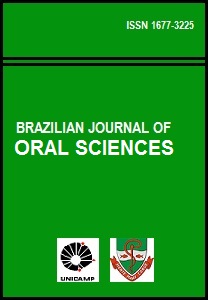Abstract
Aim: To assess the surface topography and chemical composition of three brands of as-received mini-implants (SIN®, Morelli®, and Conexao®). Methods: Twelve mini-implants of each brand were analyzed by scanning electron microscopy and energy dispersive X-ray (EDX). Results: There was no significant differences among SIN®, Morelli®, and Conexao® mini-implants comparing their surface topography by visualization of SEM micrographs and analysis of scores. The EDX analysis showed statistically significant difference among them for the amount of Ti, Al and V. Miniimplants SIN® presented also N and O in their composition. Conclusions: In conclusion, the miniimplants Morelli®, SIN® and Conexao® presented Ti as main component of the alloy. Remaining components, such as Al and V, were also observed in all the analyzed brands, with differences among them. Only SIN® mini-implants presented N and O. As far as surface topography is concerned, there are no differences among the three brands of mini-implantsReferences
Prabhu J, Cousley RR. Current products and practice: bone anchorage devices in orthodontics. J Orthod. 2006; 33: 288-307.
Kalarickal B. Group distal movement of teeth using micro-screw-implant anchorage-a case report. J Clin Diagn Res. 2014; 8: 26-9.
Rossouw E. Translational mini-screw implant research. J Orthod. 2014; 41: s8-s14.
Galli C, Piemontese M, Ravanetti F, Lumetti S, Passeri G, Gandolfini M, et al. Effect of surface treatment on cell responses to grades 4 and 5 titanium for orthodontic mini-implants. Am J Orthod Dentofacial Orthop. 2012; 141: 705-14.
Alsamak S, Psomiadis S, Gkantidis N. Positional guidelines for orthodontic mini-implant placement in the anterior alveolar region: a systematic review.
Int J Oral Maxillofac Implants. 2013; 28: 470-9.
Mizrahi E, Mizrahi B. Mini-screw implants (temporary anchorage devices): orthodontic and pre-prosthetic applications. J Orthod. 2007; 34: 80-94.
Katiæ V, Kamenar E, Blaževiæ D, Spalj S. Geometrical design characteristics of orthodontic mini-implants predicting maximum insertion torque. Korean J Orthod. 2014; 44: 177-83.
Walter A, Winsauer H, Marcé-Nogué J, Mojal S, Puigdollers A. Design characteristics, primary stability and risk of fracture of orthodontic miniimplants: pilot scan electron microscope and mechanical studies. Med Oral Patol Oral Cir Bucal. 2013; 18: e804-10.
Gonçalves JP, Shaikh AQ, Reitzig M, Kovalenko DA, Michael J, Beutner R, et al. Detonation nanodiamonds biofunctionalization and immobilization to titanium alloy surfaces as first steps towards medical application. Beilstein J Org Chem. 2014; 26: 2765-73.
Carlsson L, Rostlund T, Albretsson B, Albretsson T, Branemark PI. Osseointegration of titanium implants. Acta Orthop Scand. 1986; 57: 385-9.
Park HS, Kwon TG, Sung JH. Nonextraction treatment with microscrew implants. Angle Orthod. 2004; 74: 539-49.
Chin MYH, Sandham A, de Vries J, Van der Mei HC, Busscher HJ. Biofilm formation on surface characterized micro-implants for skeletal anchorage in orthodontics. Biomaterials. 2007; 28: 2032-40.
Silverstein J, Barreto O, França R. Miniscrews for orthodontic anchorage: nanoscale chemical surface analyses. Eur J Orthod. 2015; 13. pii: cjv007.
Jofré J, Conrady Y, Carrasco C. Survival of splinted mini-implants after contamination with stainless steel. Int J Oral Maxillofac Implants. 2010; 25: 351-6.
Vezeau PJ, Koorbusch GF, Draughn RA, Keller JC. Effects of multiple sterilization on surface characteristics and in vitro biologic responses to titanium. J Oral Maxillofac Surg 1996; 54: 738-46.
Morra M, Cassinelli C, Bruzzone G, Carpi A, Di Santi G, Giardino R, et al. Surface chemistry effects of topographic modification of titanium dental implant surfaces: 1. Surface analysis. Int J Oral Maxillofac Implants. 2003; 18: 40-5.
Carano A, Velo S, Leone P, Siciliani G. Clinical applications of the miniscrew anchorage system. J Clin Orthod. 2005; 39: 9-24.
Schätzle M, Männchen R, Zwahlen M, Lang NP. Survival and failure rates of orthodontic temporary anchorage devices: a systematic review. Clin Oral Implants Res. 2009; 20: 1351-9.
Burmann PF, Ruschel HC, Vargas IA, de Verney JC, Kramer PF. Titanium alloy orthodontic mini-implants: scanning electron microscopic and metallographic analyses. Acta Odontol Latinoam. 2015; 28: 42-7.
Melsen B. Mini-implants, where are we? J Clin Orthod. 2005; 39: 539-47.

This work is licensed under a Creative Commons Attribution 4.0 International License.
Copyright (c) 2015 Luegya Amorim Henriques Knop, Ana Prates Soares, Ricardo Lima Shintcovsk, Lidia Parsekian Martins, Luiz Gonzaga Gandini Júnior

